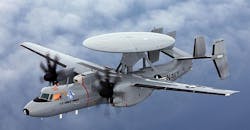Navy prepares to order two new E-2D carrier-based reconnaissance aircraft in $49.9 million deal
Officials of the Naval Air Systems Command at Patuxent River Naval Air Station, Md., are asking the Northrop Grumman Aerospace Systems segment in Melbourne, Fla., to provide long-lead parts and support for full-rate production of two Lot 7 E-2D Advanced Hawkeye aircraft.
Long-lead items either are difficult or time-consuming to obtain, and are funded early in the aircraft design process to keep overall production on schedule. Contracts to build the two E-2D aircraft will come later.
The Navy Northrop Grumman E-2D is a tactical airborne early warning (AEW) aircraft designed to operate from aircraft carriers. The twin-engine turboprop aircraft has a distinctive saucer-like antenna, and provides the carrier battle group with wide-area radar surveillance for enemy monitoring and combat air traffic control.
Related: Northrop Grumman prepares to build five E-2D Advanced Hawkeye carrier-based aircraft
Its large saucer-like radar antenna mounted to the top of the aircraft enables it to detect hostile aircraft and missiles at extremely long ranges and vector Navy aircraft to intercept.
Northrop Grumman officials call the E-2D reconnaissance aircraft a "digital quarterback" to sweep ahead of Navy aircraft carrier strike groups, manage missions, and keep U.S. network-centric carrier battle groups out of harm's way. The aircraft provides battle management, theater air and missile defense, and multi-sensor fusion capabilities.
Compared with its E-2C predecessor, the E-2D has a new radar with mechanical and electronic scanning capabilities; glass cockpit; advanced identification friend or foe (IFF) system; new mission computer and tactical workstations; electronic support measures enhancements; an d modernized communications and data link suite, Northrop Grumman officials say.
The plane is nearly 58 feet long, has an 80-foot wingspan, can fly faster than 300 knots, and can fly to altitudes as high as 37.000 feet. It carriers a crew of five: two pilots and three mission systems operators. The co-pilot also can act as a fourth mission systems operator.
The E-2D first flew in 2007, and Navy officials say they hope to procure 73 of these aircraft by 2022. These plans started going to the fleet in 2015.
Historically Northrop Grumman has managed the E-2 program from its facility in Bethpage, N.Y., but the company will assemble the aircraft in Melbourne, Fla. The company no longer builds aircraft at its Bethpage facility.
On this order Northrop Grumman will do the work in Syracuse, Greenlawn, Edgewood, and Owego, N.Y.; El Segundo, Woodland Hills, and Menlo Park, Calif. Melbourne, Fla; Rolling Meadows, Ill.; Indianapolis; Marlborough, Mass.; Independence Ohio; and other U.S. locations, and should be finished by December 2023.
For more information contact Northrop Grumman Aerospace Systems online at www.northropgrumman.com, or Naval Air Systems Command at www.navair.navy.mil.
Ready to make a purchase? Search the Military & Aerospace Electronics Buyer's Guide for companies, new products, press releases, and videos
